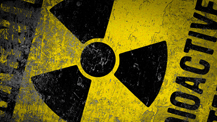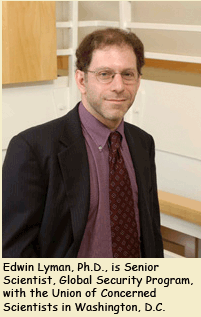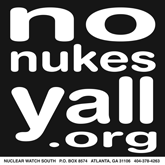

FUKUSHIMA NEWS
~ ~ ~ ~ ~ ~ ~
Help the
NO NUKES Y'ALL
campaign
y'all
Nuclear Watch South is a 501(c)(3) tax-deductible charitable organization.
{ thanks }
PayPal
It's your
safe and secure
way to donate on-line
 |
~ ~ ~ ~ ~ ~ ~

Educating and activating the grassroots to create a
nuclear-free future
~
PO Box 8574
Atlanta, GA 31106
404-378-4263
Cell 404-432-8727
info@nonukesyall.org
NO NUKES Y'ALL!
NUCLEAR WATCH SOUTH | FUKUSHIMA
STATEMENT OF DR. EDWIN LYMAN TO
SENATE ENVIRONMENT AND PUBLIC WORKS COMMITTEE
 MARCH 16, 2011 ~ On behalf of the UNION OF CONCERNED SCIENTISTS, I would like to thank
Chairman Boxer, Ranking Member Inhofe, and the other members of the
Environment and Public Works Committee for the opportunity to provide
our views on the unfolding accident at the Fukushima Dai-Ichi plant and
its implications for nuclear power in this country.
MARCH 16, 2011 ~ On behalf of the UNION OF CONCERNED SCIENTISTS, I would like to thank
Chairman Boxer, Ranking Member Inhofe, and the other members of the
Environment and Public Works Committee for the opportunity to provide
our views on the unfolding accident at the Fukushima Dai-Ichi plant and
its implications for nuclear power in this country.
The Union of Concerned Scientists would like to extend its deepest sympathies to the people of Japan during this crisis.
While the ongoing situation in Japan should be a main focus of U.S attention, we should not hesitate to ask ourselves whether we are doing all that we can do to prevent a Fukushima-like nuclear disaster from happening here.
Before proceeding, I would like to say that the Union of Concerned Scientists is neither pro nor anti-nuclear power, but has served as a nuclear power safety and security watchdog for over 40 years.
In the aftermath of the 1979 Three Mile Island accident, the NRC undertook a major overhaul of its rules to correct many of the regulatory weaknesses that the accident revealed. In contrast, seven years later, the Commission and the industry avoided learning any lessons from the far more severe Chernobyl accident because of the misleading claim that such an extreme release of radioactivity could never happen at a plant of Western design.
However, the NRC and the industry cannot hide this time behind the "it can't happen here" excuse. We have 23 plants of the same design. We have plants that are just as old. We have had station blackouts.
We have a regulatory system that is not clearly superior to that of the Japanese. We have had extreme weather events that exceeded our expectations and defeated our emergency planning measures (Katrina).
We have had close calls (e.g. Davis-Besse) that were only one additional failure away from becoming disasters. We have had full-blown disasters in other industries (e.g. BP). We have suffered a devastating terrorist air attack against our infrastructure for which we were completely unprepared.
I would ask the Committee to imagine for a moment that the crisis unfolding at Fukushima is taking place in their home states, and to consider whether this is something that Americans should ever have to endure under any circumstances.
If the answer is"no" — the right answer, in our opinion — then it is incumbent on you to thoroughly investigate whether the risk of an American Fukushima is really as low as the NRC and the industry claim.
But even though it will be a long time before we learn all the lessons from the still-evolving disaster in Japan, it is not premature to immediately take steps to reduce vulnerabilities that have long been known by regulators but have not been addressed. I will offer a few examples.
1. At least two spent fuel pools at the Fukushima plant have caught fire and are releasing radiation into the atmosphere. These pools are on the upper floor of these Mark I boiling-water reactors and are now open to the air following explosions that breached the buildings around them. The U.S. has 31 boiling-water reactors with similarly situated spent fuel pools that are far more densely packed than those at Fukushima and hence could pose far higher risks if damaged. The U.S. should act quickly to remove spent fuel from these pools and place them in dry storage casks to reduce the heat load and radioactive inventories of the pools.
2. The Fukushima accident was precipitated by an earthquake and tsunami, but the direct cause appears to have been a loss of both off-site and on-site power supplies, a situation known as a station blackout. There are many other types of initiating events that could cause such a situation, including terrorist attacks. The NRC requires U.S. plants to have the capability to cope with a station blackout for no more than four to eight hours. We need to re-evaluate the adequacy of these requirements and the effectiveness of their implementation.
3. Although the Japanese are engaged in truly heroic efforts to mitigate the worst effects of this accident and reduce radioactive releases that could harm the public, these efforts have only been partially effective, are already resulting in life-threatening conditions for the workers on site, and are likely to ultimately fail. U.S. nuclear plants have severe accident management plans, but these plans are not required by regulations and do not have to be evaluated by the NRC and tested for their effectiveness. In the case of aircraft attack on a nuclear plant, the NRC does require plants to have plans to cope with the loss of large areas of the plant due to explosion and fire. These plans will have to be re-evaluated in light of Fukushima to judge whether they can be realistically carried out. In the meantime, the NRC should place a far greater emphasis on preventing accidents and terrorist attacks rather than trying to control them afterward.
4. Elevated levels of radiation have already been detected more than one hundred miles from the release site. While these levels remain low, if the accident continues to worsen then they could increase dramatically. If there was a reactor accident in the United States, the emergency preparedness measures that would directly protect the public, including evacuation planning and potassium iodide distribution, are limited to a 10-mile radius. Whether this distance should be increased will need to be reevaluated, as will the workability of emergency plans in the context of natural disasters or terrorist attacks. There are many other areas where we believe the NRC has allowed safety margins to decrease too far. Now, not after an accident, is the time to reconsider whether the NRC’s position on “how safe is safe” is truly adequate to protect public health and safety.
Thank you for your attention, and I would be happy to answer any questions you may have.
"To the village square
we must carry the facts
of atomic energy.
From there must come America's voice."
ALBERT EINSTEIN
~~~~~~

~~~~~~
U.S. NUCLEAR POWER SAFETY ONE YEAR AFTER FUKUSHIMA
Union of Concerned Scientists
ALL THINGS NUCLEAR
Union of Concerned Scientists
UNION OF CONCERNED SCIENTISTS FACT SHEET
~~~~~~
Worldwatch Institute report finds renewables output surpasses nuclear in 2010
NUCLEAR POWER IN A POST-FUKUSHIMA WORLD
25 Years After the Chernobyl Accident
draft
World Nuclear Industry
Status Report 2010–2011
by
Mycle Schneider,
Antony Froggatt,
Steve Thomas
